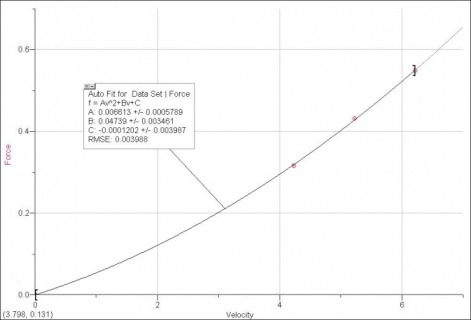Design an Experiment
What are we looking for?
The relationship between centripital force and velocity!
Equipment
- 1 Hollow Cardboard Tube
- 1 Stopwatch (On the Laptop)
- 1 Nylon String
- Rubber Stopper
- Steel Washers
- Alligater Clip
- Tape
- Meter Stick
- Ruler
What Data do we Have?
Trial 1 Regected
Mass of Weights:.0212
Force/Weights: .208
Time: .5998
Trial 2 Regected
Mass of Weights: .323
Force: .3165
Time: 8.456
Trial 3
Mass of the weights: .06285 kg Regected
Weight/Force: .61593 N
Time: .5263 seconds per revolution
Trial 4
Mass ofWeights: .044
Force: .4314
Time: .6011
Trial 5
Mass ofWeights: .056
Force: .5488
Time: .5053
Mass of Weights:.0212
Force/Weights: .208
Time: .5998
Trial 2 Regected
Mass of Weights: .323
Force: .3165
Time: 8.456
Trial 3
Mass of the weights: .06285 kg Regected
Weight/Force: .61593 N
Time: .5263 seconds per revolution
Trial 4
Mass ofWeights: .044
Force: .4314
Time: .6011
Trial 5
Mass ofWeights: .056
Force: .5488
Time: .5053
Proccedure
1. We massed the weight and alligator clip together and recorded the data.
2. We tied the Rubber Stopper to one end of the mylon string.
3. We ran the string through the cardboard tube, then tied the washers to the other end of the string, securing it with the alligator clip.
4. We measured the radius of the circle to be 50 cm.
5. We started to swing the rubber stopper. When the velocity was somewhat even, we started the stopwatch, and counted out 20 revolutions.
2. We tied the Rubber Stopper to one end of the mylon string.
3. We ran the string through the cardboard tube, then tied the washers to the other end of the string, securing it with the alligator clip.
4. We measured the radius of the circle to be 50 cm.
5. We started to swing the rubber stopper. When the velocity was somewhat even, we started the stopwatch, and counted out 20 revolutions.
Find Velocity
Trial 1
Vt =W*r
Vt = 10.4755*.5
Vt = 5.2377
Trial 2
Vt = 8.456*.5
Vt = 4.228
Trial 3
Vt= W*r
Vt = 11.9384*.5m
Vt = 5.9692 m/s
Trial 4
Vt = 10.4528*.5
Vt = 5.2264 m/s
Trial 5
Vt = 12.4345*.5
Vt = 6.21725
Vt =W*r
Vt = 10.4755*.5
Vt = 5.2377
Trial 2
Vt = 8.456*.5
Vt = 4.228
Trial 3
Vt= W*r
Vt = 11.9384*.5m
Vt = 5.9692 m/s
Trial 4
Vt = 10.4528*.5
Vt = 5.2264 m/s
Trial 5
Vt = 12.4345*.5
Vt = 6.21725
Data Analysis
Conclusion
The relationship between centripetal force and velocity is
Force = .006613v^2 + .04739v - .0001202.
However, the number of sources of error is astounding. First, the human error was significant: the radius was not kept completely constant at all times, swings weren't all at the same constant velocity, it was difficult to swing the stopper it a completely horizontal circle, the swinger was usually cautious not to hit the ceiling or someone in the head, the reaction time had to be accounted for with the stopwatch. There was friction between the string and the cardboard tube. We combined 5 different sets of data--each compiled with different equipment and different people swinging, creating an even bigger source of error. We can assume by the data collected that the relationship is indeed quadratic, however, the co-efficients may or may not be accurate.
Force = .006613v^2 + .04739v - .0001202.
However, the number of sources of error is astounding. First, the human error was significant: the radius was not kept completely constant at all times, swings weren't all at the same constant velocity, it was difficult to swing the stopper it a completely horizontal circle, the swinger was usually cautious not to hit the ceiling or someone in the head, the reaction time had to be accounted for with the stopwatch. There was friction between the string and the cardboard tube. We combined 5 different sets of data--each compiled with different equipment and different people swinging, creating an even bigger source of error. We can assume by the data collected that the relationship is indeed quadratic, however, the co-efficients may or may not be accurate.

